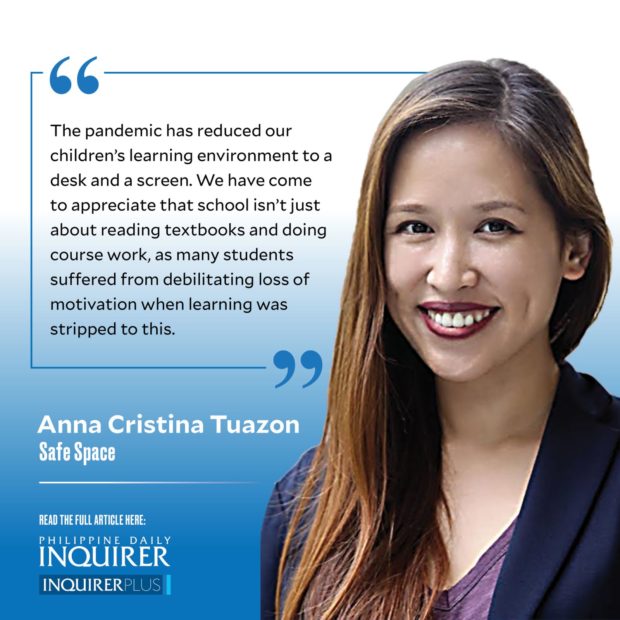I have a sinking feeling that — as painful as it was for students to transition from in-person classes to online learning — it would be just as painful to transition back to face-to-face classes after almost two years of remote learning. I’m currently guiding some child clients through this transition as their schools reopened this past week. I’m also helping my other clients mentally prepare as the Department of Education (DepEd) and the Commission on Higher Education (CHEd) have indicated the reopening of physical schools as early as December.
Most children are looking forward to returning to their old school haunts. Some muse about the snacks and treats being offered by their school cafeteria. Others already imagine the kinds of games they would play in the gym and playgrounds. Others, still, yearn to access their library and spend a cozy time in a nook with their favorite book. As they describe the world they left behind before the pandemic, I sit in uneasy silence and wonder how to break it to them that what they’re returning to won’t be quite the same.
For a lot of schools, it seems students have to stay in their seats, bordered by plastic (except in Pasig City, thank you, Mayor Vico!). Depending on their capacity to disinfect, some schools have opted for meals to be eaten in that very same seat to limit movement. We still don’t know which school facilities will be available, given safety protocols and alert levels that must be followed. Most students are eager to see and interact with their classmates again—yet we’re not quite sure what type of interaction is allowed. Are we allowed to chat with our seatmates? Are we allowed to go over to someone who has brought their BTS photocards for an informal show and tell? Are we allowed to interact with our school crush who’s from another section? While waiting to be fetched, can we have an impromptu jamming session at the lobby?
Other students have mixed feelings about returning. A few are downright terrified. We have done a great job of scaring them from stepping outside, warning that a deadly virus will kill them and their loved ones if they do. For almost two years we have trained them to fear being close to other people and they have seen us condemn others that go out. And now, off to school you go. Have fun! Some kids feel like they’re being forced to jump in a pool when they’ve already forgotten how to swim.
A lot of kids are anxious about making friends in real life (IRL, as they call it) when most of their social skills were geared toward surviving in the online environment. They fear not having a “turn off video/mute” button, realizing that they will be seen and heard, whether they like it or not. The commute — which I reminded them was something that we were used to prior to the pandemic — now seems extra cruel (I feel adults will relate to this, as well as the apparent pointlessness of meetings) and yet another adjustment they’d have to make. Skin and body image issues have returned to plague my adolescent clients, worried that filters are no longer there to shield them. Social anxiety, which had a partial reprieve during online learning, has now come back in full force to paralyze my clients.
The pandemic has reduced our children’s learning environment to a desk and a screen. We have come to appreciate that school isn’t just about reading textbooks and doing course work, as many students suffered from debilitating loss of motivation when learning was stripped to this. We realize the value of relationships—with teachers and our classmates—in facilitating motivation and learning. We realize that what we consider ancillary are actually essential: the library, playgrounds, gym, gazebos, and other sitting/lounging areas. Hopefully, we also realize that learners need both structure and non-structure. They need enough structure to help them focus and enough downtime in order to digest what they’ve learned (as the rapid pace of online modules, driven by the pressure of outcome-based education touted by DepEd and CHEd, have made students feel like bots churning out requirements left and right).
I hope that we have collected wisdom — instead of fears — during this pandemic. What we shouldn’t do is to transplant the remote learning setup to a physical classroom — that’s the worst of both worlds. Instead, we should create a learning environment that facilitates experiences in a safe and fun manner. We may not be able to go back to the way it was, but we can build something better.


